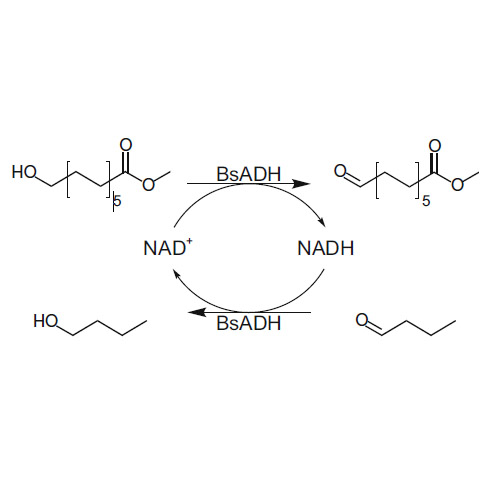Stability engineering of the Geobacillus stearothermophilus alcohol dehydrogenase and application for the synthesis of a polyamide 12 precursor
02-Sep-2015
Appl Microbiol Biotechnol, Volume 99, Issue 24, pp 10501-10513, DOI 10.1007/s00253-015-6930-5
The thermostable NAD+-dependent alcohol dehydrogenase from Geobacillus stearothermophilus (BsADH) was exploited with regard to the biocatalytic synthesis of ω-oxo lauric acid methyl ester (OLAMe), a key intermediate for biobased polyamide 12 production, from the corresponding long-chain alcohol. Recombinant BsADH was produced in Escherichia coli as a homogeneous tetrameric enzyme and showed high activity towards the industrially relevant substrate ω-hydroxy lauric acid methyl ester (HLAMe) with K M = 86 μM and 44 U mg−1. The equilibrium constant for HLAMe oxidation to the aldehyde (OLAMe) with NAD+ was determined as 2.16 × 10−3 from the kinetic parameters of the BsADH-catalyzed forward and reverse reactions. Since BsADH displayed limited stability under oxidizing conditions, the predominant oxidation-prone residue Cys257 was mutated to Leu based on sequence homology with related enzymes and computational simulation. This substitution resulted in an improved BsADH variant exhibiting prolonged stability and an elevated inactivation temperature. Semi-preparative biocatalysis at 60 °C using the stabilized enzyme, employing butyraldehyde for in situ cofactor regeneration with only catalytic amounts of NAD+, yielded up to 23 % conversion of HLAMe to OLAMe after 30 min. In contrast to other oxidoreductases, no overoxidation to the dodecanoic diacid monomethyl ester was detected. Thus, the mutated BsADH offers a promising biocatalyst for the selective oxidation of fatty alcohols to yield intermediates for industrial polymer production.











